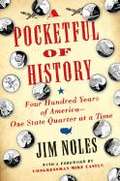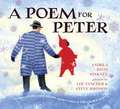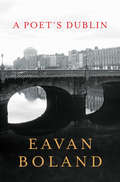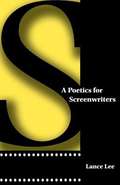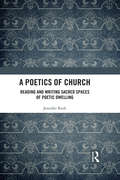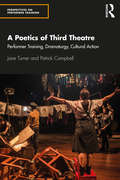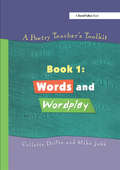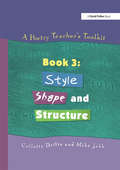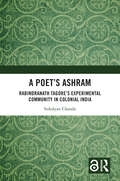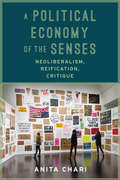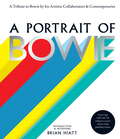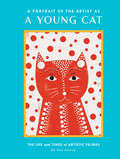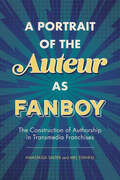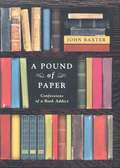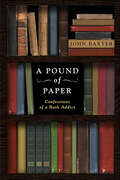- Table View
- List View
A Pocket Guide to Vans (Pocket Guides to Fashion)
by Josh SimsIn this illustrated guide, bestselling style writer Josh Sims explores the Vans phenomenon from the brand's overnight success thanks to Sean Penn in Fast Times at Ridgemont High to its status as a style staple worn by the diverse likes of Justin Bieber and Iron Maiden.The shoes are beloved for their superior grip and endlessly customizable designs. And like skateboarding - an outsider sport gone global - it has ridden many ups and downs to become a cultural icon.
A Pocket Guide to Vans (Pocket Guides to Fashion)
by Josh SimsIn this illustrated guide, bestselling style writer Josh Sims explores the Vans phenomenon from the brand's overnight success thanks to Sean Penn in Fast Times at Ridgemont High to its status as a style staple worn by the diverse likes of Justin Bieber and Iron Maiden.The shoes are beloved for their superior grip and endlessly customizable designs. And like skateboarding - an outsider sport gone global - it has ridden many ups and downs to become a cultural icon.
A Pocketful of History: Four Hundred Years of America One State Quarter at a Time
by Jim NolesA HISTORY-RICH LOOK at the coins in your pocket-the fifty state quarters-and what they tell us about "changing" America Our past is all around us-even in the spare change jangling in your purse or pocket. For the past decade, the United States Mint has offered America a pocketful of history through its popular 50 State Quarters® Program. When the final quarters are released, thousands of us will have collected these commemorative coins, one for each state and territory in the Union. But what can we learn about our country's stories and lore from a mere $12.50 in state quarters? Jim Noles's fascinating book, A Pocketful of History, looks at each quarter in turn to answer these curious questions . . . * Who is Caesar Rodney and why is he riding a horse on Delaware's quarter? * What is the real history behind Abraham Lincoln's political career in his home state Illinois? * What happened to New Hampshire's symbol, the "Old Man in the Mountain," three years after its quarter was minted? * What famous racecourse is memorialized on the quarter from the state known as the "Crossroads of America"? Congress recently extended the program to include six additional quarters for Washington, D.C., and the affiliated territories of the United States, to be released in 2009. Why is Pennsylvania known a the Keystone State? Why did California choose to honor preservationist John Muir rather than a mining '49er? . . . and many, many more. A Pocketful of History tells the story behind each state's quarter-how each state chose its design; what is important about the people, scenes, and themes depicted on the coins; and what the collection tells us about ourselves. It's an entertaining and enlightening journey through four hundred years of America in twenty-five-cent doses.
A Poem for Peter: The Story of Ezra Jack Keats and the Creation of The Snowy Day
by Rosemary Wells Andrea Davis Pinkney Steve Johnson Lou Fancher<p>A celebration of the extraordinary life of Ezra Jack Keats, creator of The Snowy Day. <p>The story of The Snowy Day begins more than one hundred years ago, when Ezra Jack Keats was born in Brooklyn, N.Y. The family were struggling Polish immigrants, and despite Keats's obvious talent, his father worried that Ezra's dream of being an artist was an unrealistic one. But Ezra was determined. By high school he was winning prizes and scholarships. Later, jobs followed with the WPA and Marvel comics. But it was many years before Keats's greatest dream was realized and he had the opportunity to write and illustrate his own book. <p>For more than two decades, Ezra had kept pinned to his wall a series of photographs of an adorable African American child. In Keats's hands, the boy morphed into Peter, a boy in a red snowsuit, out enjoying the pristine snow; the book became The Snowy Day, winner of the Caldecott Medal, the first mainstream book to feature an African American child. It was also the first of many books featuring Peter and the children of his -- and Keats's -- neighborhood. <p>Andrea Davis Pinkney's lyrical narrative tells the inspiring story of a boy who pursued a dream, and who, in turn, inspired generations of other dreamers.</p>
A Poet's Dublin
by Eavan BolandJuxtaposing verse and image, A Poet's Dublin is a study of origin and influence from "a major Irish poet" (Edward Hirsch). Written over years, the transcendent and moving poems in A Poet's Dublin seek out shadows and impressions of a powerful, historic city, studying how it forms and alters language, memory, and selfhood. The poems range from an evocation of the neighborhoods under the hills where the poet lived and raised her children to the inner-city bombing of 1974, and include such signature poems as "The Pomegranate," "The War Horse," and "Anna Liffey." Above all, these poems weave together the story of a self and a city--private, political, and bound by history. The poems are supported by photographs of the city at all times and in all seasons: from dawn on the river Liffey, which flows through Dublin, to twilight up in the Dublin foothills.
A Poetics for Screenwriters
by Lance LeeWriting successful screenplays that capture the public imagination and richly reward the screenwriter requires more than simply following the formulas prescribed by the dozens of screenwriting manuals currently in print. Learning the "how-tos" is important, but understanding the dramatic elements that make up a good screenplay is equally crucial for writing a memorable movie. In A Poetics for Screenwriters, veteran writer and teacher Lance Lee offers aspiring and professional screenwriters a thorough overview of all the dramatic elements of screenplays, unbiased toward any particular screenwriting method.<P><P> Lee explores each aspect of screenwriting in detail. He covers primary plot elements, dramatic reality, storytelling stance and plot types, character, mind in drama, spectacle and other elements, and developing and filming the story. Relevant examples from dozens of American and foreign films, including Rear Window, Blue, Witness, The Usual Suspects, Virgin Spring, Fanny and Alexander, The Godfather, and On the Waterfront, as well as from dramas ranging from the Greek tragedies to the plays of Shakespeare and Ibsen, illustrate all of his points.<P> This new overview of the dramatic art provides a highly useful update for all students and professionals who have tried to adapt the principles of Aristotle's Poetics to the needs of modern screenwriting. By explaining "why" good screenplays work, this book is the indispensable companion for all the "how-to" guides.
A Poetics of Church: Reading and Writing Sacred Spaces of Poetic Dwelling
by Jennifer ReekThis innovative book aims to create a ‘poetics of Church’ and a ‘religious imaginary’ as alternatives to more institutional and conventional ways of thinking and of being ‘Church’. Structured as a spiritual and literary journey, the work moves from models of the institutional Catholic Church into more radical and ambiguous textual spaces, which the author creates by bringing together an unorthodox group of thinkers referred to as ‘poet-companions’: the 16th-century founder of the Society of Jesus, Ignatius of Loyola, the French thinkers Gaston Bachelard and Hélène Cixous, the French poet Yves Bonnefoy, and the English playwright Dennis Potter. Inspired especially by the reading and writing practices of Cixous, the author attempts to exemplify Cixous’ notion of écriture féminine—‘feminine writing’—that suggests new ways of seeing and relating. The project’s uniting of Ignatian spirituality with postmodern thinking and its concern with creating new theological, literary and spiritual spaces for women both coincide and contrast with Pope Francis’s pastoral and reformist tendencies, which have neglected to adequately address the marginalisation of women in the Church. As Francis has called for ‘a theology of women’, of which there are, of course, many to draw from, this volume will be a timely contribution with a unique interdisciplinary approach.
A Poetics of Third Theatre: Performer Training, Dramaturgy, Cultural Action (Perspectives on Performer Training)
by Patrick Campbell Jane TurnerA Poetics of Third Theatre offers an in-depth, critical analysis of Third Theatre, a transnational community of theatre groups and artists united by a shared set of values and a laboratory attitude. This book takes a genealogical account of Third Theatre as a concept and a practice that draws attention to the historical Third Theatre Encounters that have taken place across Europe and Latin America since the 1970s. The work of renowned Third Theatre groups and organisations, such as LUME (Brazil), Grupo Cultural Yuyachkani (Peru), Triangle Theatre (UK) and Nordisk Teaterlaboratorium – NTL (Denmark), are explored to reveal how a multifarious poetics of Third Theatre is manifest through these artists’ approaches to performer training, dramaturgy and cultural action. Three critical pillars – unconditional hospitality, artisanal craft and (re)enchantment – are employed in order to illuminate the shared ethos of the Third Theatre community and its exemplification as a mode of cultural performance. This informative text will be of great use to students and scholars of drama and theatre studies, and its dedicated section on performer training exercises offers the reader pathways into an experiential engagement with Third Theatre craft.
A Poetry Teacher's Toolkit: Book 1: Words and Wordplay
by Collette Drifte Mike JubbProfessional poets spend many hours crafting a finished piece of work, yet we expect children in school to sit down and write when they are told to, whether they feel inspired or not. This series of four books is a toolkit to help you build a positive framework for children to read, write, understand and enjoy poetry - to bring a creative spark to the poetry classroom. A combination of featured poems, creative ideas, structured lesson plans and differentiated photocopiable activity sheets gives the series a uniquely flexible approach - which means you can use the materials in any classroom context. If you're wary of poetry, if you think it's boring, or if you're nervous about teaching poetry, then you've chosen the right book. Key themes covered in BOOK 1: Words and Wordplay are playing with words; making patterns with words; words and meanings; puns and puzzles; how words affect readers; moods, feelings and attitudes; and how poets manipulate words. Other books in the series are: BOOK 2: Rhymes, Rhythms and Rattles; BOOK 3: Style, Shape and Structure; and BOOK 4: Language and Performance.
A Poetry Teacher's Toolkit: Book 2: Rhymes, Rhythms and Rattles
by Collette Drifte Mike JubbProfessional poets spend many hours crafting a finished piece of work, yet we expect children in school to sit down and write when they are told to, whether they feel inspired or not. This series of four books is a toolkit to help you build a positive framework for children to read, write, understand and enjoy poetry - to bring a creative spark to the poetry classroom. A combination of featured poems, creative ideas, structured lesson plans and differentiated photocopiable activity sheets gives the series a uniquely flexible approach - which means you can use the materials in any classroom context. If you're wary of poetry, if you think it's boring, or if you're nervous about teaching poetry, then you've chosen the right book. Key themes covered in BOOK 2: Rhymes, Rhythms and Rattles are rhythm and rhyme in poetry, sounds, alliteration, words to create effects, onomatopoeia, and metaphor and simile. Other books in the series are: BOOK 1: Words and Wordplay; BOOK 3: Style, Shape and Structure; and BOOK 4: Language and Performance.
A Poetry Teacher's Toolkit: Book 3: Style, Shape and Structure
by Collette Drifte Mike JubbProfessional poets spend many hours crafting a finished piece of work, yet we expect children in school to sit down and write when they are told to, whether they feel inspired or not. This series of four books is a toolkit to help you build a positive framework for children to read, write, understand and enjoy poetry - to bring a creative spark to the poetry classroom. A combination of featured poems, creative ideas, structured lesson plans and differentiated photocopiable activity sheets gives the series a uniquely flexible approach - which means you can use the materials in any classroom context. If you're wary of poetry, if you think it's boring, or if you're nervous about teaching poetry, then you've chosen the right book. Key themes covered in BOOK 3: Style, Shape and Structure are style and structure, addressing regular and standard forms, the impact of layout, free form, 'found' poetry, and concrete poetry. Other books in the series are: BOOK 1: Words and Wordplay; BOOK 2: Rhymes, Rhythms and Rattles; and BOOK 4: Language and Performance.
A Poetry Teacher's Toolkit: Book 4: Language and Performance
by Collette Drifte Mike JubbProfessional poets spend many hours crafting a finished piece of work, yet we expect children in school to sit down and write when they are told to, whether they feel inspired or not. This series of four books is a toolkit to help you build a positive framework for children to read, write, understand and enjoy poetry - to bring a creative spark to the poetry classroom. A combination of featured poems, creative ideas, structured lesson plans and differentiated photocopiable activity sheets gives the series a uniquely flexible approach - which means you can use the materials in any classroom context. If you're wary of poetry, if you think it's boring, or if you're nervous about teaching poetry, then you've chosen the right book. Key themes covered in BOOK 4: Language and Performance are moods and feelings through the use of effective language; nonsense and humorous verse; the continuity and links between ancient and modern, between nursery and playground rhymes and Shakespeare; whatever our ability, there is a place for everyone on the poetry 'ladder'; and performance poetry. Other books in the series are: BOOK 1: Words and Wordplay; BOOK 2: Rhymes, Rhythms and Rattles; and BOOK 3: Style, Shape and Structure.
A Poet’s Ashram: Rabindranath Tagore’s Experimental Community in Colonial India
by Sukalyan ChandaThe remarkably creative life Rabindranath Tagore (1861–1941) lived has long been an area of scholarly enquiry. Yet, surprisingly, his role as the founder of an experimental ashram community remains unexplored. A Poet’s Ashram retrieves his idea of his ashram through an exploration of his writings on the institutions he built.The ashram community Tagore endeavoured to create in Santiniketan during the period 1901–1941 was his response to the question of modernity. Through his effort to reinvent the ancient Indian ideal of the ashram, he articulated his idea of a mode of collective living that was meant to be grounded in a set of ethical values derived from India’s civilizational inheritance. This book traces the history of how his ashram school evolved into a community that practised egalitarianism, inclusiveness and creativity through its daily existence. It explores a range of nineteenth- and twentieth-century discourses and Tagore’s engagement with them in order to situate that idea within its historical context, a critical juncture in the history of modern India and the world. This book’s reading of his project unravels its anti-colonial underpinnings and the commonalities it shared with some of the other similar experimental communities that challenged illiberal ideologies and power relations during the early twentieth century.Meticulously researched and perceptively written, this book will be of interest to students and researchers of history, political science, culture studies and postcolonial studies. It will also be of interest to educationists, educators and those interested in colonial modernity, modern Indian history, philosophy of education, institution building, peace, inclusivity and sustainability.
A Political Economy of the Senses: Neoliberalism, Reification, Critique (New Directions in Critical Theory #2)
by Anita ChariAnita Chari revives the concept of reification from Marx and the Frankfurt School to spotlight the resistance to neoliberal capitalism now forming at the level of political economy and at the more sensate, experiential level of subjective transformation. Reading art by Oliver Ressler, Zanny Begg, Claire Fontaine, Jason Lazarus, and Mika Rottenberg, as well as the politics of Occupy Wall Street, Chari identifies practices through which artists and activists have challenged neoliberalism's social and political logics, exposing its inherent tensions and contradictions.
A Portrait Of Leni Riefenstahl
by Audrey SalkeldLeni Riefenstahl will always be remembered for her brilliant film of the 1936 Olympic Games in Berlin - still rated as one of the best documentaries ever made. Before that she was acclaimed for her roles in silent feature films, when German cinema was in its artistic heyday in the 1920s. She pioneered the box office success of such classic mountaineering dramas as The White Hell of Piz Palu and then began to direct her own films. The Blue Light was admired by Hitler and led to her filming the Wagnerian Nuremberg Rally of 1934. After the war she was shunned by the film industry, despite a court in 1952 proclaiming her not guilty of supporting the Nazis in a punishable way. Her undoubted charisma led to many affairs and grandiose schemes - deep sea diving in her seventies and still filming wildlife in her nineties. Audrey Salkeld has sifted the fact from the legend and gives us a moving portrait of the great movie `star' who suffered more in the `wilderness' than her enduring fame suggests.
A Portrait of Bowie: A tribute to Bowie by his artistic collaborators and contemporaries
by Brian HiattA strikingly unique tribute to David Bowie, comprising a collection of 40 visual portraits of the icon throughout his career, and text tributes by his artistic collaborators and contemporaries.
A Portrait of Bowie: A tribute to Bowie by his artistic collaborators and contemporaries
by Brian HiattHIS LIFE WAS A WORK OF ARTNow, artists and musicians who worked with David Bowie during his lifetime - or who were his contemporaries - pay tribute to the icon through their own words on what it was like to work in collaboration with a man whose fluid artistic genius repeatedly broke boundaries, right up until his death. Alongside these text tributes are 40 stunning illustrative and photographic portraits of Bowie throughout his career. The contributing artists and photographers include (alphabetically): Edward Bell, Derek Boshier, Anton Corbijn, Kevin Cummins, Chuck Connelly, Chalkie Davies, Stephen Finer, Greg Gorman, Derry Moore, Terry O'Neill, Mick Rock, Masayoshi Sukita, George Underwood, Justin de Villeneuve and more. Alongside these remarkable portraits are insightful, personal written pieces by his contemporaries, and musicians and artists who worked closely with Bowie, including Zachary Alford, Carlos Alomar, Toni Basil, Gail Ann Dorsey, Mike Garson, Dana Gillespie, Debbie Harry and Chris Stein, Cyndi Lauper, and Nile Rodgers, among others. The book is curated by Brian Hiatt, of Rolling Stone magazine, as General Editor.** Newly revised and improved ebook edition, optimized for both small- and large-screen devices **
A Portrait of Joan: The Autobiography of Joan Crawford
by Joan CrawfordOne of Hollywood’s greatest stars recalls her fabulous life: at nine, scrubbing floors in a Kansas City school; at twenty, motion picture stardom and marriage to Douglas Fairbanks, Jr.; in 1945, the Academy Award for her sensational comeback-triumph in Mildred Pierce; and today, a glamorous “double life” as Hollywood star and corporation executive.Richly illustrated with photographs throughout.
A Portrait of the Artist as a Young Cat: Life and Times of Artistic Felines
by Nia GouldA Portrait of the Artist as a Young Cat is a book of more than 20 influential artists reimagined as artistic felines.From Frida Catlo to Yayoi Catsama, Wassily Catdinski to Henri Catisse, each portrait of the artist as a young cat is accompanied by a clever tongue-in-cheek biography revealing the thrilling feline lives (all nine) behind their famed artwork.Loaded with clever cat puns, this playful romp through art history will twist the whiskers of any cat-loving creative, whether you're discovering the inspiration for Frida Catlo's renowned self-pawtraits to reflecting on the catmosphere that gave rise to Georgia O'Kitty's landscapes.• Features fantastic feline artists such as Mary Catsatt and Meow Weiwei• A cute and clever book that cat and art lovers alike will love• Packed with tons of real biographical info about each artist and plentiful cat punsFor cat lovers with an artistic purr-suasion, this is the ultimate celebration of their favorite artists.• A purrfectly smart and sweet book for cat lovers, art lovers, pun enthusiasts, and those who love them• Great for those who loved Fat Cat Art by Svetlana Petrova, Cats Galore by Susan Herbert, Of Cats and Men: Profiles of History's Great Cat-Loving Artists, Writers, Thinkers and Statesmen by Sam Kalda
A Portrait of the Auteur as Fanboy: The Construction of Authorship in Transmedia Franchises
by Anastasia Salter Mel StanfillIncreasingly over the past decade, fan credentials on the part of writers, directors, and producers have come to be seen as a guarantee of quality media making—the “fanboy auteur.” Figures like Joss Whedon are both one of “us” and one of “them.” This is a strategy of marketing and branding—it is a claim from the auteur himself or industry PR machines that the presence of an auteur who is also a fan means the product is worth consuming. Such claims that fan credentials guarantee quality are often contested, with fans and critics alike rejecting various auteur figures as the true leader of their respective franchises. That split, between assertions of fan and auteur status and acceptance (or not) of that status, is key to unravelling the fan auteur.In A Portrait of the Auteur as Fanboy: The Construction of Authorship in Transmedia Franchises, authors Anastasia Salter and Mel Stanfill examine this phenomenon through a series of case studies featuring fanboys. The volume discusses both popular fanboys, such as J. J. Abrams, Kevin Smith, and Joss Whedon, as well as fangirls like J. K. Rowling, E L James, and Patty Jenkins, and dissects how the fanboy-fangirl auteur dichotomy is constructed and defended by popular media and fans in online spaces, and how this discourse has played in maintaining the exclusionary status quo of geek culture. This book is particularly timely given current discourse, including such incidents as the controversy surrounding Joss Whedon’s so-called feminism, the publication of Harry Potter and the Cursed Child, and contestation over authorial voices in the DC cinematic universe, as well as broader conversations about toxic masculinity and sexual harassment in Hollywood.
A Posing Techniques: For Photographing Model Portfolios
by Billy PegramWith detailed discussions and eye-catching, dynamic images, this guidebook shows professional photographers how to masterfully create beautiful images of a model to achieve any creative objective. Instructions illustrate basic poses as well as a host of subtle variations to provide photographers with an endless array of looks for editorial fashion shots, athletics, glamour or nude photography, and shots designed to show curves, reveal personality, or showcase the hands, hair, or legs. This comprehensive resource also provides expert advice on conducting a successful session, how to work with the model, how to work with a support staff of image stylists, and tips for designing a high-quality portfolio. Additional lessons provide a start-to-finish analysis of four different shooting sessions, each with a different model and a different objective.
A Post-Nationalist History of Television in Ireland
by Edward BrennanThis book explores the question of how society has changed with the introduction of private screens. Taking the history of television in Ireland as a case study due to its position at the intersection of British and American media influences, this work argues that, internationally, the transnational nature of television has been obscured by a reliance on institutional historical sources. This has, in turn, muted the diversity of audience experiences in terms of class, gender and geography. By shifting the focus away from the default national lens and instead turning to audience memories as a key source, A Post-Nationalist History of Television in Ireland defies the notion of a homogenous national television experience and embraces the diverse and transnational nature of watching television. Turning to people’s memories of past media, this study ultimately suggests that the arrival of the television in Ireland, and elsewhere, was part of a long-term, incremental change where the domestic and the intimate became increasingly fused with the global.
A Postcard History of the Passenger Liner
by Christopher DeakesFrom around 1880, for almost a hundred years, shipowners commissioned a wealth of paintings that depicted their magnificent liners as well as the routes they travelled, their exotic destinations, and life onboard. These paintings, rich in imagination and atmosphere, appeared on postcards and posters of the day and were used to advertise the companies and their ships; and so was born a whole genre that produced tens of thousands of paintings which formed a wonderful record of the great era of the passenger liner.In 1900, there were over thirty shipping companies operating passenger liners across the North Atlantic. Other oceans were similarly served. But now, with just a few exceptions, the companies and their liners have disappeared along with the art they once inspired. Little remains to recall this aspect of our maritime past except the postcards; and they tell an evocative story of the vanished world of elegant ships and leisurely travel, of social and political times much changed by the history of the past century.Here, brought vividly to life in more than 500 colourful postcards, are the ships on which so many of our predecessors sailed—as emigrants, soldiers, administrators, or simply as tourists—in days long past. These cards, which are now highly collectable, show how steamships developed over the years, but they are also a fine tribute to the artists who painted them. This volume also includes a glossary of some 170 illustrators, which forms an important reference section, and advice on collecting.
A Pound of Paper: Confessions of a Book Addict
by John BaxterIN THE RURAL AUSTRALIA OF THE FIFTIES where John Baxter grew up, reading books was regarded with suspicion, owning and collecting them with utter incomprehension. Despite this, by the age of eleven Baxter had "collected" his first book-The Poems of Rupert Brooke. He'd read the volume often, but now he had to own it. This was the beginning of what would become a major collection and a lifelong obsession. His book hunting would take him all over the world, but his first real find was in London in 1978, when he spotted a rare copy of a Graham Greene children's book while browsing a stall in Swiss Cottage. It was going for 5 pence. This would also, fortuitously, be the day when he first encountered one of the legends of the book-selling world-Martin Stone. At various times pothead, international fugitive from justice, and professional rock musician, he would become John's mentor and friend. In this brilliantly readable and funny book, John Baxter brings us into contact with such literary greats as Graham Greene, Kingsley Amis, I. . Ballard, and Ray Bradbury. But he also shows us how he penetrated the secret fraternity of "runners" or book scouts- sleuths who use bluff and guile to hunt down their quarry-and joined them in scouring junk shops, markets, auction rooms, and private homes for rarities. In the comic tradition of Clive James's Unreliable Memoirs, A Pound of Paper describes how a boy from the bush came to be living in a Paris penthouse with a library worth millions. It also explores the exploding market in first editions. What treasures are lying unnoticed in your garage?
A Pound of Paper: Confessions of a Book Addict
by John BaxterIn the rural Australia of the fifties where John Baxter grew up, reading books was disregarded with suspicion, owning and collecting them with utter incomprehension. Despite this, by the age of eleven Baxter had 'collected' his first book - The Poems of Rupert Brooke. He'd read the volume often, but now he had to own it. This was the beginning of what would become a major collection and a lifelong obsession.His book-hunting would take him all over the world, but his first real find was in London in 1978, when he spotted a rare copy of a Graham Greene children's book while browsing on a stall in Swiss Cottage. It was going for 5 pence. This would also, fortuitously, be the day when he first encountered one of the legends of the book-selling world: Martin Stone. At various times pothead, international fugitive from justice, and professional rock musician, he would become John's mentor and friend.In this brilliantly readable and funny book, John Baxter brings us into contact with such literary greats as Graham Greene, Kingsley Amis, J.G. Ballard and Ray Bradbury. But he also shows us how he penetrated the secret fraternity of 'runners' or book scouts - sleuths who use bluff and guile to hunt down their quarry - and joined them in scouring junk shops, markets, auction rooms and private homes for rarities.In the comic tradition of Clive James's Unreliable Memoirs, A Pound of Paper describes how a boy from the bush came to be living in a Paris penthouse with a library worth millions. It also explores the exploding market in first editions. What treasures are lying unnoticed in your garage?

